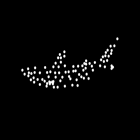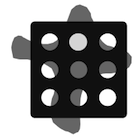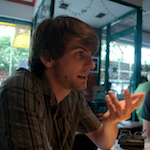Vicky Froyen researcher - scientist
I am a Post-Doctoral Associate at SUNY College of Optometry (USA) with Prof. Qasim Zaidi. I did my B.A in Psychology and M.A. in Experimental Psychology at K.U.Leuven (Belgium). After graduating in 2010 I continued my academic endeavors with Prof. Jacob Feldman and Prof. Manish Singh at Rutgers University (USA), where in 2013 I received my Ph.D. in Psychology.
Keywords: perceptual science, cognitive science, artificial intelligence, machine learning, computer vision, psychophysics
Bayesian Hierarchical Grouping
Perceptual grouping, the process by which elements are organized into distinct objects, is one of the most important problems the visual system has to solve. Here we propose a generalized framework for understanding the principles underlying perceptual grouping based on a single idea: an image is a mixture of objects. This framework has shown account for several subproblems in perceptual grouping, including contour integration, dot clustering and part decomposition. Recently, we also applied our approach to succesfully decompose 3D objects into parts as a first step towards a 3D object-recognition system.
Collaborators: Jacob Feldman, Manish Singh, Tarek El-Gaaly, Ahmed Elgammal
- Froyen, V., Feldman, J., & Singh, M. (submitted). Bayesian estimation of the number of perceptual clusters. Manuscript submitted for review.
- Froyen, V., Feldman, J., & Singh, M. (accepted). Bayesian Hierarchical Grouping: perceptual grouping as mixture estimation. Psychological Review.
El-Gaaly, T., Froyen, V., Elgammal, A., Feldman, J., & Singh, M. (2015). A Bayesian approach to perceptual 3D object-part decomposition using skeleton-based representations. AAAI Conference on Artificial Intelligence.
-
Feldman, J., Singh, M. & Froyen, V. (2014). Perceptual grouping as Bayesian mixture estimation. Invited chapter for: Oxford Handbook of Computational Perceptual Organization. Gepshtein, S., Maloney, L. T., & Singh, M. (Eds.). Oxford University Press.

Non-Rigid-Structure-from-Motion
Our world is full of 3D objects that deform over time, for example animals, trees and clouds. Rigorously defining a unique global motion and shape for deforming objects presents a challenge. Yet, the human visual system seems to readily disentangle object motions from non-rigid deformations, in order to categorize objects, recognize the nature of actions such as running or jumping, and even to infer intentions.In this recent new project we are exploring and developing novel algorithms for computing NRSfM, informed by psychophysical and physiological experiments. Since this is still fresh and ongoing work, specifics will be posted at a later time. Stay tuned!
Collaborators: Qasim Zaidi
Coming soon!
Rotating Columns Illusion
The Rotating Columns Illusion (on the left) is a rich illusion which relates otherwise distinct research topics of geometric cues to figure-ground, accretion-deletion cue to depth, and structure-from-motion. The original illusion, published in 2013, sprouting exciting new research on structure-from-motion, and a plethora of work on the interaction between accretion-deletion and geometric cues to figure-ground. The latter puts to trial the current assumption that accretion-deletion might be a self-sufficient cue to 3D depth.
Collaborators: Daglar Tanrikulu, Xiaoli (Lily) He, Jacob Feldman, Manish Singh.
-
Tanrikulu, O. D., Froyen, V., Singh, M., & Feldman, J. (submitted). Geometric figure-ground cues override standard depth from accretion-deletion. Manuscript submitted for review.
-
Froyen, V., Feldman, J., & Singh, M. (2013). Rotating columns: relating structure- from-motion, accretion/deletion, and figure/ground. Journal of Vision, 13(10), 1-12.

Figure-ground computation
Figure-ground computation, in which the visual image is divided into nearer (figural) and farther (ground) surfaces, was my first research endeavor in visual perception. Most of my work has focussed on researching global influences on figure-ground computation, both from a computational as well as from an experimental perspective. Computationally we studied two distinct global cues: (1) we constructed a Bayesian framework showing the usefulness of skeletons (medial axis) for figure-ground computation; (2) we showed the importance and usefullness of surface property (e.g. color) consistency in figure-ground computation.
Collaborators: Jacob Feldman, Manish Singh, Naoki Kogo, Johan Wagemans.
-
Kogo, N., & Froyen, V. (2014). Border-ownership computation reflecting consistency of surface properties. Annual Meeting of the Vision Sciences Society (VSS), May 2014
- Kogo, N., Froyen, V., & Wagemans, J.(2013).A new model for border-ownership com- putation reflecting global configuration and consistency of surface properties. European Conference on Visual Perception (ECVP), August 2013
-
Froyen, V., Feldman, J., & Singh M. (2010). A Bayesian framework for figure-ground interpretation. In Advances in Neural Information Processing Systems 23, J. Lafferty, C. K. I. Williams, J. Shawe-Taylor, R. Zemel, and A. Culotta, Eds., pp. 631-639.
Journal Publications
-
Froyen, V., Feldman, J., & Singh, M. (accepted). Bayesian Hierarchical Grouping: perceptual grouping as mixture estimation. Psychological Review.
-
Froyen, V., Feldman, J., & Singh, M. (2013). Rotating columns: relating structure- from-motion, accretion/deletion, and figure/ground. Journal of Vision, 13(10), 1-12.
-
Froyen, V., Feldman, J., & Singh, M. (submitted). Bayesian estimation of the number of perceptual clusters. Manuscript submitted for review.
-
Tanrikulu, O. D., Froyen, V., Singh, M., & Feldman, J. (submitted). Geometric figure-ground cues override standard depth from accretion-deletion. Manuscript submitted for review.
Conference Proceedings
-
El-Gaaly, T., Froyen, V., Elgammal, A., Feldman, J., & Singh, M. (2015). A Bayesian approach to perceptual 3D object-part decomposition using skeleton-based representations. AAAI Conference on Artificial Intelligence.
-
Froyen, V., Feldman, J., & Singh M. (2010). A Bayesian framework for figure-ground interpretation. In Advances in Neural Information Processing Systems 23, J. Lafferty, C. K. I. Williams, J. Shawe-Taylor, R. Zemel, and A. Culotta, Eds., pp. 631-639.
Book Chapters
-
Feldman, J., Singh, M. & Froyen, V. (2014). Perceptual grouping as Bayesian mixture estimation. Invited chapter for: Oxford Handbook of Computational Perceptual Organization. Gepshtein, S., Maloney, L. T., & Singh, M. (Eds.). Oxford University Press.
-
Feldman, J., Singh, M., Briscoe, E., Froyen, V., Kim, S. & Wilder, J. (2013). An integrated Bayesian approach to shape representation and perceptual organization. In: Shape Perception in Human and Computer Vision: An Interdisciplinary Perspective. S. Dickinson & Z. Pizlo (Eds.). Springer Verlag
Conference Abstracts and Presentations [for older presentations see cv]
- Tanrikulu, O. D., Froyen, V., Ma, L., Singh, M., & Feldman, J. (2014). A cue combina- tion study of depth ordering from accretion-deletion and contour convexity. European Conference on Visual Perception (ECVP), August 2014.
- Froyen, V., Feldman, J., & Singh, M. (2014). Bayesian Hierarchical Grouping in perceptual organization. European Conference on Visual Perception (ECVP), August 2014. - oral presentation.
- Froyen, V. (2014). Bayesian Hierarchical Grouping: A probabilistic approach to skeleton-based representation of shape. Invited Symposium: "Symmetry: theory and applications", Annual Meeting of the Society for Mathematical Psychology (Math- Psych), July 2014 - oral presentation.
- Kogo, N., & Froyen, V. (2014). Border-ownership computation reflecting consistency of surface properties. Annual Meeting of the Vision Sciences Society (VSS), May 2014
- Tanrikulu, O. D., Froyen, V., Ma, L., Singh, M., & Feldman, J. (2014). Combination of contour convexity and accretion/deletion in the perception of relative depth. Annual Meeting of the Vision Sciences Society (VSS), May 2014.
- Froyen, V., Singh, M., & Feldman, J. (2014). Bayesian Hierarchical Grouping: percep- tual grouping as mixture estimation. Annual Meeting of the Vision Sciences Society (VSS), May 2014 - oral presentation.
- Froyen, V., Feldman, J., & Singh, M. (2014). Bayesian Hierarchical Grouping: a framework for perceptual grouping. MODVIS, May 2014 - oral presentation.
- Kogo, N., & Froyen, V. (2014). Computation of border-ownership reflecting consis- tency of surface properties. MODVIS, May 2014.
- Froyen, V., Feldman, J., & Singh, M. (2013). A Bayesian mixture model framework for understanding perceptual grouping. Configural Processing Consortium (CPC), November 2013 - oral presentation.
Work Experience
2014-.... Post-doctoral Associate @ SUNY College of Optometry (USA)
Advisor: Prof. Qasim Zaidi, Ph.D.
2013-2014 Post-doctoral Associate @ Rutgers University (USA)
Advisors: Prof. Jacob Feldman, Ph.D., & Prof. Manish Singh, Ph.D
Education
2013 Ph.D. Psychology / Cognitive Science @ Rutgers University (USA)
Advisors: Prof. Jacob Feldman, Ph.D., & Prof. Manish Singh, Ph.D
Dissertation Title: Bayesian estimation of mixture models for perceptual grouping
2010 M.Sc./M.A. Experimental Psychology @ K.U.Leuven (Belgium)
Advisor: Prof. Ralf Krampe, Ph. D.
Thesis Title: Rhythmic timing and movement trajectories in musical expertise
2008 B.A. Psychology @ K.U.Leuven (Belgium)
Research Assistent to Naoki Kogo, Ph. D.
Supervisor: Prof. Johan Wagemans, Ph. D.
